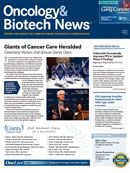Publication
Article
Oncology & Biotech News
Novel Epigenetic Therapy Shows Clinical Activity in Hematologic Malignancies
Author(s):
Preliminary evidence supports the use of bromodomain inhibitors in hematologic malignancies, including acute leukemia (mainly acute myelogenous leukemia) and other hematological malignancies, including diffuse large B-cell lymphoma and multiple myeloma.
Esteban Cvitkovic, MD
Preliminary evidence supports the use of bromodomain inhibitors in hematologic malignancies, including acute leukemia (mainly acute myelogenous leukemia) and other hematological malignancies, including diffuse large B-cell lymphoma and multiple myeloma. Phase I results of treatment with OTX015, a bromodomain inhibitor, were presented at the 2014 AACR Annual Meeting.
“So far, results have been encouraging. The drug has a good safety profile and significant activity in patients with [acute leukemia] and [other hematologic malignancies]. We have been excited to see that several of these patients who failed all standard therapy have durable objective responses to monotherapy with oral OTX015 at doses with little or no toxicity. As far as we know, this is the first clinical evidence that BET-bromodomain inhibitors may have a role in the treatment of human malignancies,” stated Esteban Cvitkovic, MD, founder and Chief Scientific Officer of Oncoethix.
The bromodomain and extraterminal (BET) subfamily of bromodomain proteins partly determine whether a gene is turned on or off. These proteins attach to special epigenetic flags on the genome. The epigenetic flags have an abnormal position in different cancer types, turning genes on or off and driving the cancer process.
OTX015 is an oral small molecule inhibitor of the BET bromodomain proteins BRD2, 3, and 4. Preclinical studies suggest that this agent may be effective against a wide variety of cell lines, including leukemia, lymphoma, and myeloma. The drug appears to be additive with most conventional cytotoxic chemotherapies.
The phase I study that Cvitkovic reported enrolled 42 patients (21 with acute leukemia and 21 with other hematologic malignancies). Patients were assigned to a single dose of OTX015 once daily (10 mg, 20 mg, 40 mg, or 80 mg) or to 40 mg twice daily. For each dosing regimen, there were three to six patients with acute leukemia and three to six patients with other hematologic malignancies.
Significant activity was observed in seven of 38 evaluable patients (four with acute leukemia and three with other hematologic malignancies); four were treated at the 80 mg/day dosage, one at 10 mg/day, and two at 40 mg/day. Treatment of three of these seven patients is ongoing. Cvitkovic said that these seven patients met response criteria, but there was additional evidence of clinical activity in four other patients who did not fulfill standard response criteria. “You need at least 3 months to be sure the patient is responding,” he said.
No dose-limiting toxicity was observed for acute leukemia patients. The maximum-tolerated dose was not reached at 80 mg/day or 40 mg twice daily. For patients with other hematologic malignancies, thrombocytopenia was a dose-limiting toxicity. The maximum-tolerated dose was not reached at 80 mg/ day but was exceeded at 40 mg twice daily, suggesting schedule-dependent toxicity. Dose escalation with 120 mg once daily is currently being explored.
Planned studies include a phase II trial of single-agent OTX015 in adult and pediatric solid tumors and a phase I/II study of combination therapy in selected hematologic malignancies.
Formal discussant of the trial, James Bradner, MD, Dana-Farber Cancer Institute, said, “We are excited about this early preliminary proof-of-concept study. OTX015 has good tolerability, suggesting it may be used more broadly. Complete responses were seen [with this compound]—even in highly aggressive, multiple refractive patients—when [it was] used as a single agent. We look forward to combination studies.”
Herait PE, Berthon C, Thieblemont C, et al. BET-bromodomain inhibitor OTX015 shows clinically meaningful activity at nontoxic doses: interim results of an ongoing phase I trial in hematologic malignancies. Presented at: 2014 AACR Annual Meeting; April 5-9, 2014; San Diego, CA. Abstract CT231.










